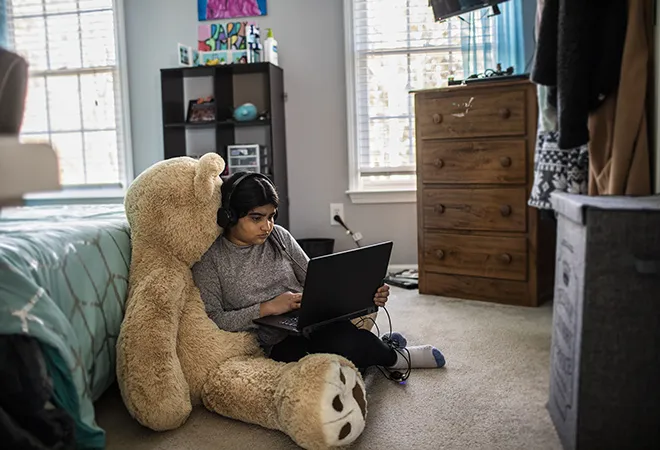
Since early 2020,
growing numbers of children have begun spending more time on the Internet as a result of the lockdowns and school closures caused by the pandemic. As
UNICEF has observed, the rise in children’s screen time has put their online safety at risk and increased their chances of exposure to harmful behaviour and content.
Cases of online sexual abuse and exploitation of children worldwide have
surged since the COVID-19 outbreak. In India, cybercrimes against children in 2020 rose by more than
400 percent by 2019. Nearly 90 percent of these crimes involved the publication or transmission of child sexual abuse material (CSAM). The increased use of social media platforms, the mass migration to online classes, and the use of educational apps have all been found to threaten children’s online safety.
OCSAE could include a range of activities such as producing and distributing CSAM; luring children into sexual chats or generating explicit content; grooming and enticing children to meet the abuser in the real world; exhibitionism by the abuser.
Of the six classes of
online risks for children that UNICEF identifies, sexual abuse and sexual exploitation may be considered in conjunction and referred to as online child sexual abuse and exploitation (OCSAE). OCSAE could include a range of activities such as producing and distributing CSAM; luring children into sexual chats or generating explicit content; grooming and enticing children to meet the abuser in the real world; exhibitionism by the abuser; and permitting a child to engage in prostitution or sexual trafficking over the Internet.
Where does India stand on child online safety?
India was an early ratifier of the
UN Convention on the Rights of the Child (CRC) of 1990, and in 2002 it acceded to the Second Optional Protocol to the CRC which further strengthens the CRC’s provisions for online and offline offences against children.
India has evolved a robust
legal framework for protecting children online. This includes the Protection of Children against Sexual Offences (POCSO) Act, 2012; the Information Technology (Amendment) Act, 2008 which widens the scope of the IT Act, 2000 by identifying offences to which children are most vulnerable; and the more recent Information Technology (Intermediary Guidelines and Digital Media Ethics Code) Rules, 2021 that aims to curb the circulation of CSAM on social media platforms. Moreover, sections of the Indian Penal Code and the Immoral Traffic Prevention Act also provide a basis for reporting instances of OCSAE such as the sale and circulation of obscene materials; sexual harassment, defamation, criminal intimidation of children; and online extortion and child trafficking.
The
2020 Child Safety Online Index, a survey of 30 countries conducted during the pandemic’s first year, ranks India ninth (with an ‘average’ rating) for having the ‘best online safety for children’ but second in terms of the ‘extent of cyber-risks’ faced by children. This appears to indicate that children in India face a high volume and wide range of cyber-risks, but the country’s efficacy in dealing with these risks is ‘average’.
The 2020 Child Safety Online Index, a survey of 30 countries conducted during the pandemic’s first year, ranks India ninth (with an ‘average’ rating) for having the ‘best online safety for children’ but second in terms of the ‘extent of cyber-risks’ faced by children.
- Addressing OCSAE during the pandemic
India has responded to the wave of OCSAE during the pandemic in four ways. It has unscaled its promotion of existing mechanisms for reporting online offences against children; tried to crack down on the presence of CSAM online, especially on social media; focused on sensitising schools, and continued to build the capacity of law enforcement agencies (LEAS) and boost technological capacity to counter threats to child safety.
- Raising awareness about OCSAE reporting mechanisms
India’s two chief mechanisms for self-reporting OCSAE—the POCSO e-Box, a virtual complaint management system and the National Cybercrime Reporting Portal (NCRP)—have both been in operation since before the pandemic. Since early 2020, the National Commission on the Protection of Child Rights (NCPCR) and the National Commission on Women have redoubled efforts to raise awareness about these reporting platforms and the POCSO and IT Acts, systematically rolling out
programmes for outreach, advocacy and stakeholder engagement across the country. A further mechanism drawn upon during the pandemic has been the
information-sharing arrangement in effect since 2019 between India’s National Crime Records Bureau (NCRB) and America’s National Centre for Missing and Exploited Children (NCMEC). The NCRB receives Tipline reports from the NCMEC, which it then shares with state-level LEAS, encouraging them to take action.
These initiatives are praiseworthy but the general lack of awareness about India’s OCSAE reporting platforms continues to be a challenge, translating into an abysmally low number of self-reported crimes. In 2020-21 the POCSO e-Box registered
151 complaints and in 2020 the NCRP recorded
1,102 cybercrimes against children. By contrast, the NCRB received
2,725,518 reports of OCSAE from the NCMEC in 2020 alone.
- Trying to crack down on CSAM on social media platforms
The controversial
Information Technology (Intermediary Guidelines and Digital Media Ethics Code) Rules, 2021 constitute the sole new piece of legislation passed during the pandemic that seeks to address the issue of CSAM on social media. The IT Rules call upon social media intermediaries to prohibit their users from publishing or transmitting CSAM; make it mandatory for intermediaries to develop tools to identify CSAM and block user access to such content. More contentiously, the rules enjoin upon intermediaries to help trace the first originator of information when confronted with a judicial order for the investigation or prosecution of an offence related to CSAM or sexually explicit material.
The IT Rules call upon social media intermediaries to prohibit their users from publishing or transmitting CSAM; make it mandatory for intermediaries to develop tools to identify CSAM and block user access to such content.
The IT Rules are problematic. For social media platforms to help trace content, they would have to break their
end-to-end encryption, compromising the security of all online communications on the platforms. Besides, the rules do not suggest a definite mechanism for enforcing traceability. Also, given that the IT Act from which the rules stem does not empower the government to dictate technical changes to platforms, the very
legality of the rules becomes debatable. Thus, while in principle the IT Rules seek to tackle OCSAE, it is hard to see how they might be implemented unless these issues are resolved.
Sensitising schools about OCSAE and other online threats to children has been a key focus of India’s pandemic response. The
NCPCR and
Ministry of Education have both developed and circulated manuals for school safety that also serve as compendia of existing guidelines, laws, and reporting mechanisms related to children’s cyber safety.
Apex bodies like the Central Board for Secondary Education and National Council for Educational Research and Training too have released student-friendly handbooks on online child safety issues, and trained teachers on cyber-safety.
These Centre-driven initiatives seek to make schools more accountable for sensitising their administrators and teachers about online child safety and to sensitise school children directly. It is important though that state governments ensure the adoption of similar tools across schools at the state level. The development of state cyber-safety monitoring mechanisms for schools could lead to greater compliance.
The NCPCR and Ministry of Education have both developed and circulated manuals for school safety that also serve as compendia of existing guidelines, laws, and reporting mechanisms related to children’s cyber safety.
- Strengthening human and technological capacity
Finally, the
training of LEAs and judicial officers under the ‘Cyber Crime Prevention against Women and Children’ scheme run by the Ministry of Home Affairs has continued with renewed urgency during the pandemic. These efforts to build human capacity are being complemented by technological initiatives by Big Tech firms to tackle OCSAE ever since the pandemic began. In India, for example, both
Google and
Facebook have taken steps to remove CSAM from their platforms, and launched programmes to educate children about online safety.
The way forward
As India enters into the third year of the pandemic, it would do well to assess how it could strengthen its OCSAE response systems.
Limited awareness about OCSAE prevention laws, resources and reporting mechanisms continues to be a major stumbling block. Sensitisation efforts must become significantly more visible and sustained. Online child safety should not be perceived merely as a matter of crisis response occasioned by the pandemic.
A phased nationwide 360-degree awareness campaign, supported by the Indian mass media could act as a critical first step toward generating the necessary public attention. Simultaneously, integrating modules on OCSAE into computer science and sex education curricula at schools—while ensuring that centrally developed knowledge products are made available in multiple regional languages—could go a long way towards sensitising the audiences that are most at risk. Third, India’s disturbingly large
backlog of cases of crimes against children urgently needs to be addressed, and efforts must be made to fast-track cases of OCSAE on a priority basis.
Integrating modules on OCSAE into computer science and sex education curricula at schools—while ensuring that centrally developed knowledge products are made available in multiple regional languages—could go a long way towards sensitising the audiences that are most at risk.
The private sector will have to be an ally in the war against OCSAE. The IT Rules, 2021 need a sensitive and thorough re-appraisal before they can realistically be implemented by social media intermediaries. While the recently proposed
draft amendments to these rules include a few suggestions that could have positive outcomes, the controversial clauses about traceability and decryption remain unchanged. Further, India has so far been
largely unable to persuade Internet service providers to cooperate with efforts to block access to CSAM. This record needs to improve.
Finally, India could adopt a more outward-looking approach and explore bilateral or multilateral partnerships to promote child safety online. Strategic partnerships could be considered with countries such as Australia that are known for their robust mechanisms for addressing OCSAE, and with whom India already collaborates on a range of cyber and technology initiatives. Working together to exchange knowledge, develop the capacity of LEAs, and disrupt operations of CSAM offenders could be highly advantageous for both partners, and could help build a safer and more secure cyberspace for children.
K Sanjay Kumar,
Is Your Child Safe? (Kozhikode: The Book People, 2017), pp.46–58
The views expressed above belong to the author(s). ORF research and analyses now available on Telegram! Click here to access our curated content — blogs, longforms and interviews.



 Since early 2020,
Since early 2020,  PREV
PREV


